Effect of Three-Dimensional (3D) Scanning Factors on Minimizing the Scanning Errors Using a White LED Light 3D Scanner
Abstract
Highlights
- Of the main effects, MW and simplification (70%) were found to be optimal levels of watertight and simplification in almost all the scanning modes, regardless of sample geometry. Moreover, two sample geometries were scanned three dimensionally and are referred to as simple and complex samples in this research;
- The scanning errors were found to be lower for the complex sample, i.e., up to 0.1%, when compared to errors for the simple sample. The reduction in error up to such an extent was never reported before;
- Three-dimensional scanning research implies that the scanning of complex product components is preferred to the scanning of simple components, which may be easily modelled geometrically.
- Mode A of 3D scanning for complex sample was evaluated to be the optimal among all other modes of 3D scanning.
Abstract
1. Introduction
2. Materials and Methods
2.1. Factor Settings before 3D Scanning (Pre-Scanning Factors)
2.2. Factor Settings after 3D Scanning (Post-Scanning Factors)
3. Results and Discussions
3.1. Three-Dimensional Scanning of Sample 1
Practical Implications of Modes of 3D Scanning for Sample 1
3.2. Three-Dimensional Scanning of Sample 2
Practical Implications of Modes of 3D Scanning for Sample 2
4. Conclusions
- A simple object has complexity in scanned data for all modes of 3D scanning in terms of insignificant factors and high values of severity indices (SIs) which cause high error PCRs. Therefore, simple objects should logically and decisively be modeled using CAD software, which can save time and money instead of proceeding with 3D scanning.
- Medium detail watertightness and a simplicity of 70% were frequently concluded to be the optimal levels of watertightness and simplification in all modes of 3D scanning regardless of geometrical intricacies in simple and complex geometries.
- With mode A of 3D scanning for complex geometry, only one 3D scanning factor was significant, i.e., watertightness. However, an un-watertight watertightness and a simplification of 70% were the optimal levels of watertightness and simplification, respectively, for complex geometry. This implies that mode A is recommended for scanning complex objects which have detailed scanning specifications, e.g., texture, smoothness, and all four levels of watertightness.
- Irrespective of the sample geometry, error PCRs were lower for mode A and complex geometry. Hence, a combined effect of more than two levels of 3D scanning factors was expectedly significant in all modes of 3D scanning, helping us to justify the reason for which all modes of 3D scanning frequently delivered statistically insignificant factors except mode A for complex geometry. This is another way of verifying the suitability of mode A for the 3D scanning of complex objects.
Supplementary Materials
Author Contributions
Funding
Institutional Review Board Statement
Informed Consent Statement
Data Availability Statement
Acknowledgments
Conflicts of Interest
References
- Chadha, A.; Haq, M.U.; Raina, A.; Singh, R.; Penumarti, N.; Bishnoi, M.S. Effect of fused deposition modelling process parameters on mechanical properties of 3D printed parts. World J. Eng. 2019, 16, 550–559. [Google Scholar] [CrossRef]
- Geng, Z.; Bidanda, B. Review of reverse engineering systems–current state of the art. Virtual Phys. Prototyp. 2017, 12, 161–172. [Google Scholar] [CrossRef]
- Pescaru, R.; Kyratsis, P.; Oancea, G. A Case Study of Reverse Engineering Integrated in an Automated Design Process. OP Conf. Series Mater. Sci. Eng. 2016, 161, 12029. [Google Scholar] [CrossRef]
- Tóth, T.; Živčák, J. A comparison of the outputs of 3D scanners. Procedia Eng. 2014, 69, 393–401. [Google Scholar] [CrossRef]
- Gonzalez-perez, I.; Fuentes-aznar, A. Reverse engineering of spiral bevel gear drives reconstructed from point clouds. Mech. Mach. Theory 2022, 170, 104694. [Google Scholar] [CrossRef]
- Haleem, A.; Javaid, M. 3D scanning applications in medical field: A literature-based review. Clin. Epidemiol. Glob. Health 2019, 7, 199–210. [Google Scholar] [CrossRef]
- Anwer, N.; Mathieu, L. From reverse engineering to shape engineering in mechanical design. CIRP Ann. 2016, 65, 165–168. [Google Scholar] [CrossRef]
- Qie, Y.; Bickel, S.; Wartzack, S.; Schleich, B.; Anwer, N. A function-oriented surface reconstruction framework for reverse engineering. CIRP Ann. 2021, 70, 135–138. [Google Scholar] [CrossRef]
- Bauer, F.; Schrapp, M.; Szijarto, J. Accuracy analysis of a piece-to-piece reverse engineering workflow for a turbine foil based on multi-modal computed tomography and additive manufacturing. Precis. Eng. 2019, 60, 63–75. [Google Scholar] [CrossRef]
- Yang, Y.; Fang, H.; Fang, Y.; Shi, S. Three-dimensional point cloud data subtle feature extraction algorithm for laser scanning measurement of large-scale irregular surface in reverse engineering. Measurement 2020, 151, 107220. [Google Scholar] [CrossRef]
- Yanamandra, K.; Chen, G.; Xu, X.; Mac, G.; Gupta, N. Reverse engineering of additive manufactured composite part by toolpath reconstruction using imaging and machine learning. Compos. Sci. Technol. 2020, 198, 108318. [Google Scholar] [CrossRef]
- Che, J.; Zhang, Y.; Wang, H.; Liu, Y.; Du, M.; Ma, S.; Zhao, Y.; Suo, C. A novel method for analyzing working performance of milling tools based on reverse engineering. J. Pet. Sci. Eng. 2020, 197, 107987. [Google Scholar] [CrossRef]
- Wang, P.; Yang, J.; Hu, Y.; Huo, J.; Feng, X. Innovative design of a helmet based on reverse engineering and 3D printing. Alex. Eng. J. 2021, 60, 3445–3453. [Google Scholar] [CrossRef]
- Liu, X.; Wei, Y.; Wu, H.; Zhang, T. Factor analysis of deformation in resistance spot welding of complex steel sheets based on reverse engineering technology and direct finite element analysis. J. Manuf. Process. 2020, 57, 72–90. [Google Scholar] [CrossRef]
- Segreto, T.; Bottillo, A.; Teti, R.; Galantucci, L.; Lavecchia, F.; Galantucci, M.B. Non-contact Reverse Engineering Modeling for Additive Manufacturing of Down Scaled Cultural Artefacts. Procedia CIRP 2017, 62, 481–486. [Google Scholar] [CrossRef]
- Segreto, T.; Bottillo, A.; Caggiano, A.; Martorelli, M. Integration of reverse engineering and ultrasonic non-contact testing procedures for quality assessment of CFRP aeronautical components. Procedia CIRP 2019, 79, 343–348. [Google Scholar] [CrossRef]
- Engel, B.; Al-Maeeni, S.S.H. An integrated reverse engineering and failure analysis approach for recovery of mechanical shafts. Procedia CIRP 2019, 81, 1083–1088. [Google Scholar] [CrossRef]
- Irzmańska, E.; Okrasa, M. Evaluation of protective footwear fit for older workers (60+): A case study using 3D scanning technique. Int. J. Ind. Ergon. 2018, 67, 27–31. [Google Scholar] [CrossRef]
- Haleem, A.; Javaid, M. Enablers, Barriers, and Critical Success Factors for Effective Adoption of Color-Jet 3D Printing Technology. J. Ind. Integr. Manag. 2019, 7, 599–625. [Google Scholar] [CrossRef]
- Javaid, M.; Haleem, A. Additive manufacturing applications in medical cases: A literature based review. Alexandria J. Med. 2018, 54, 411–422. [Google Scholar] [CrossRef]
- Maloney, T.R. Experimental and archaeological testing with 3D laser scanning reveals the limits of I/TMC as a reduction index for global scraper and point studies. J. Archaeol. Sci. Rep. 2019, 29, 102068. [Google Scholar] [CrossRef]
- Andrews, E.T.; Ashton, J.; Pearson, F.; Beattie, R.; Johnson, M.J. Handheld 3D scanning as a minimally invasive measuring technique for neonatal anthropometry. Clin. Nutr. ESPEN 2019, 33, 279–282. [Google Scholar] [CrossRef] [PubMed]
- Piperi, E.; Bodi, I. Scanning, 3D GD & T Inspection for automotive plastic elements. In Proceedings of the 9th International Textile Conference & 3rd International Conference on Engineering and Entrepreneurship 2021, Tirana, Albania, 18–19 December 2021. [Google Scholar]
- Bodi, I.; Piperi, E.; Kaçani, J. Design and production of footwear using CAD/CAM systems. In Proceedings of the 9th International Textile Conference & 3rd International Conference on Engineering and Entrepreneurship 2021, Tirana, Albania, 18–19 December 2021. [Google Scholar]
- Paper, C.; Spahiu, T.; Politeknik, U.; Piperi, E.; Politeknik, U. Extracting body dimensions from 3D body scanning. In Proceedings of the 6th International Conference of Textile, Tirana, Albania, 20 November 2014; Volume 20, pp. 1–11. [Google Scholar]
- Galantucci, L.M.; Piperi, E.; Lavecchia, F.; Zhavo, A. Semi-automatic low cost 3D Laser scanning systems for reverse engineering. Procedia CIRP 2015, 28, 94–99. [Google Scholar] [CrossRef]
- Piperi, E.; Galantucci, L.; Bodi, I. 3D Low-cost scanning systems development for mechanical parts digi-talization. In Proceedings of the 1st International Conference “Engineering and Entrepreneurship”, Tirana, Albania, 8–10 December 2017; pp. 1–8. [Google Scholar]
- Vazzana, A.; Higgins, O.A.; Oxilia, G.; Lugli, F.; Silvestrini, S.; Nava, A.; Bondioli, L.; Bortolini, E.; Di Domenico, G.; Bernardini, F.; et al. Reports High-accuracy methodology for the integrative restoration of archaeological teeth by using reverse engineering techniques and rapid prototyping. J. Archaeol. Sci. Rep. 2022, 44, 103511. [Google Scholar] [CrossRef]
- Lazarević, D.; Nedić, B.; Jović, S.; Šarkoćević, Ž.; Blagojević, M. Optical inspection of cutting parts by 3D scanning. Phys. A Stat. Mech. its Appl. 2019, 531, 121583. [Google Scholar] [CrossRef]
- Feng, P.; Zou, Y.; Hu, L.; Liu, T. Use of 3D laser scanning on evaluating reduction of initial geometric imperfection of steel column with pre-stressed CFRP. Eng. Struct. 2019, 198, 109527. [Google Scholar] [CrossRef]
- Javaid, M.; Haleem, A. Current status and applications of additive manufacturing in dentistry: A literature-based review. J. Oral Biol. Craniofacial Res. 2019, 9, 179–185. [Google Scholar] [CrossRef]
- Javaid, M.; Haleem, A.; Kumar, L. Dimensional errors during scanning of product using 3D scanner. In Advances in Engineering Design, 1st ed.; Springer: Singapore, 2019; pp. 727–736. [Google Scholar] [CrossRef]
- Raja, V.; Fernandes, K.J. Reverse Engineering: An Industrial Perspective; Springer: London, UK, 2008; p. 242. [Google Scholar] [CrossRef]
- Ghahremani, K.; Safa, M.; Yeung, J.; Walbridge, S.; Haas, C.; Dubois, S. Quality assurance for high-frequency mechanical impact (HFMI) treatment of welds using handheld 3D laser scanning technology. Weld. World 2014, 59, 391–400. [Google Scholar] [CrossRef]
- Azlan, K.A.; Omar, M.; Hussin, M.; Abdullah, M.; Chinniah, E.S. Measurement Accuracy Assessment for Laser Triangulation 3D Scanning Machine. Int. J. Recent Technol. Eng. 2020, 8, 2789–2793. [Google Scholar] [CrossRef]
- Yu, F.; Zeng, L.; Pan, D.; Sui, X.; Tang, J. Evaluating the accuracy of hand models obtained from two 3D scanning techniques. Sci. Rep. 2020, 10, 1–10. [Google Scholar] [CrossRef] [PubMed]


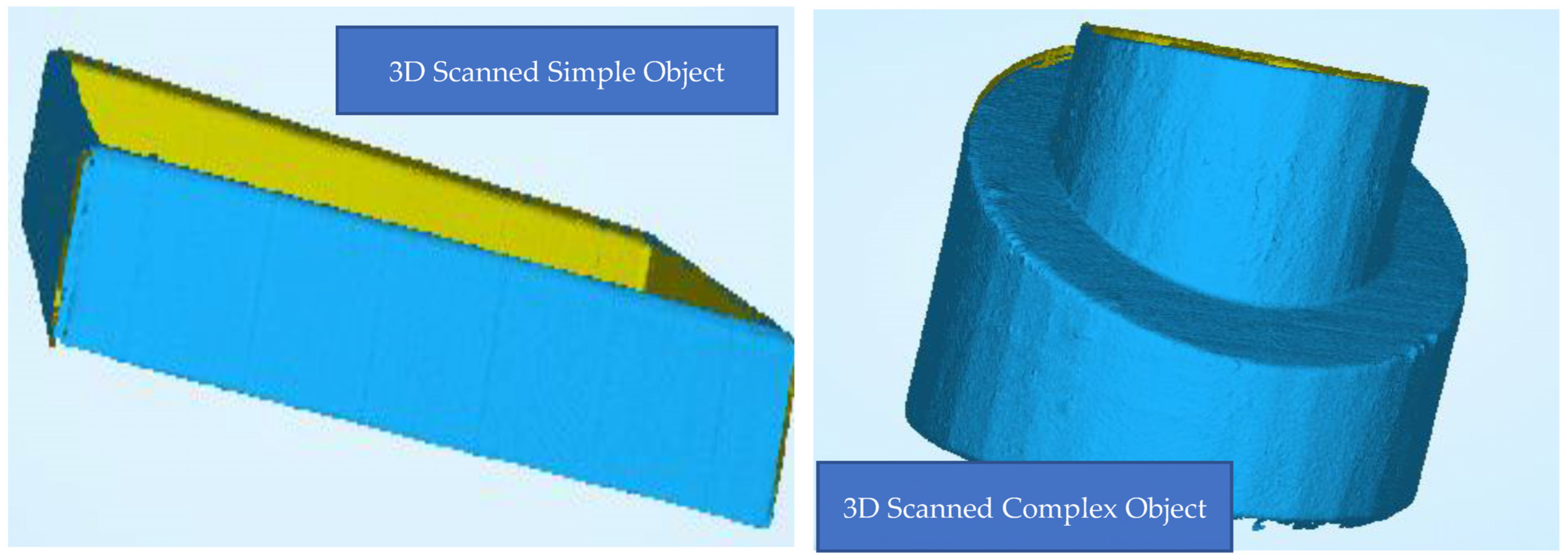
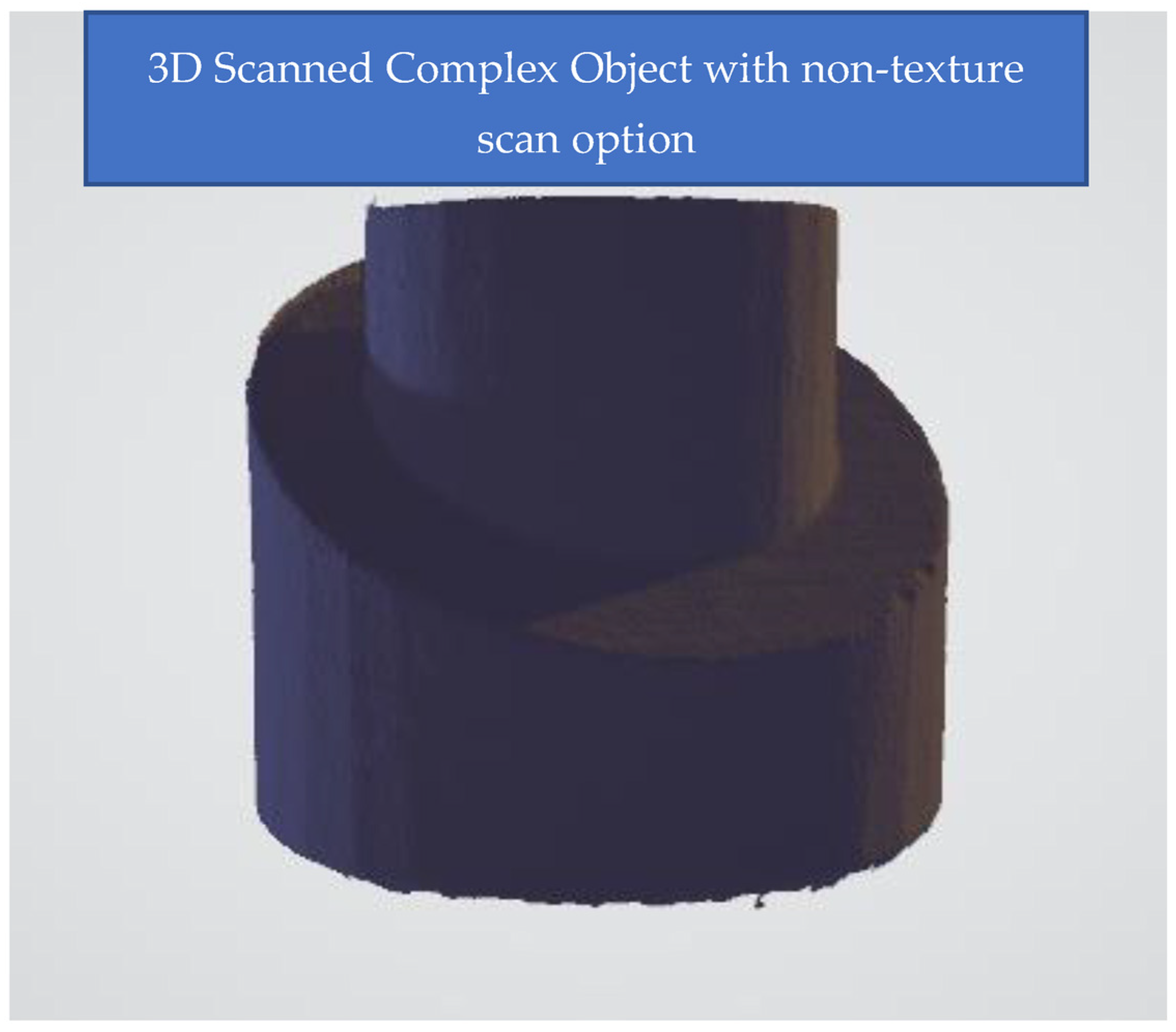
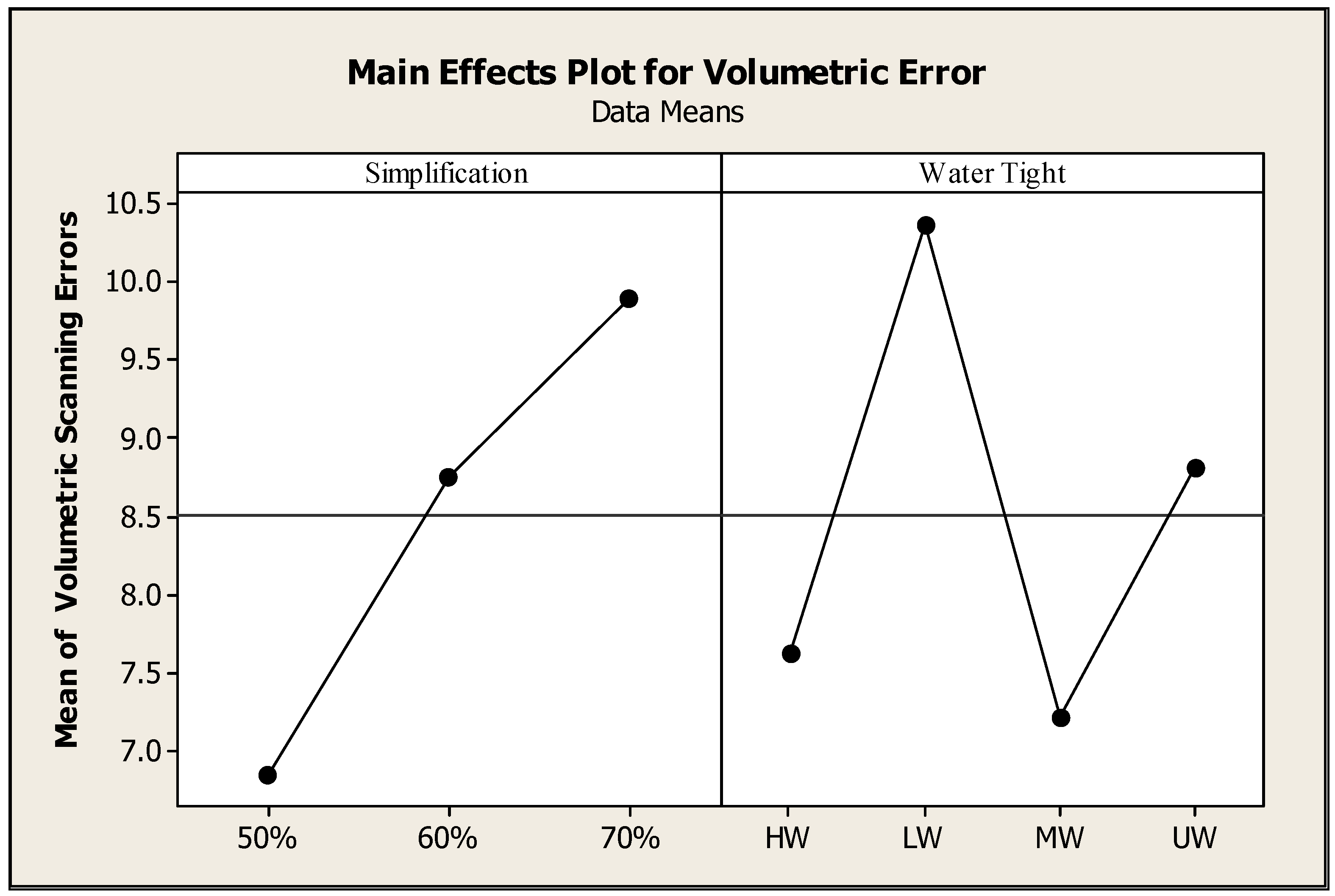
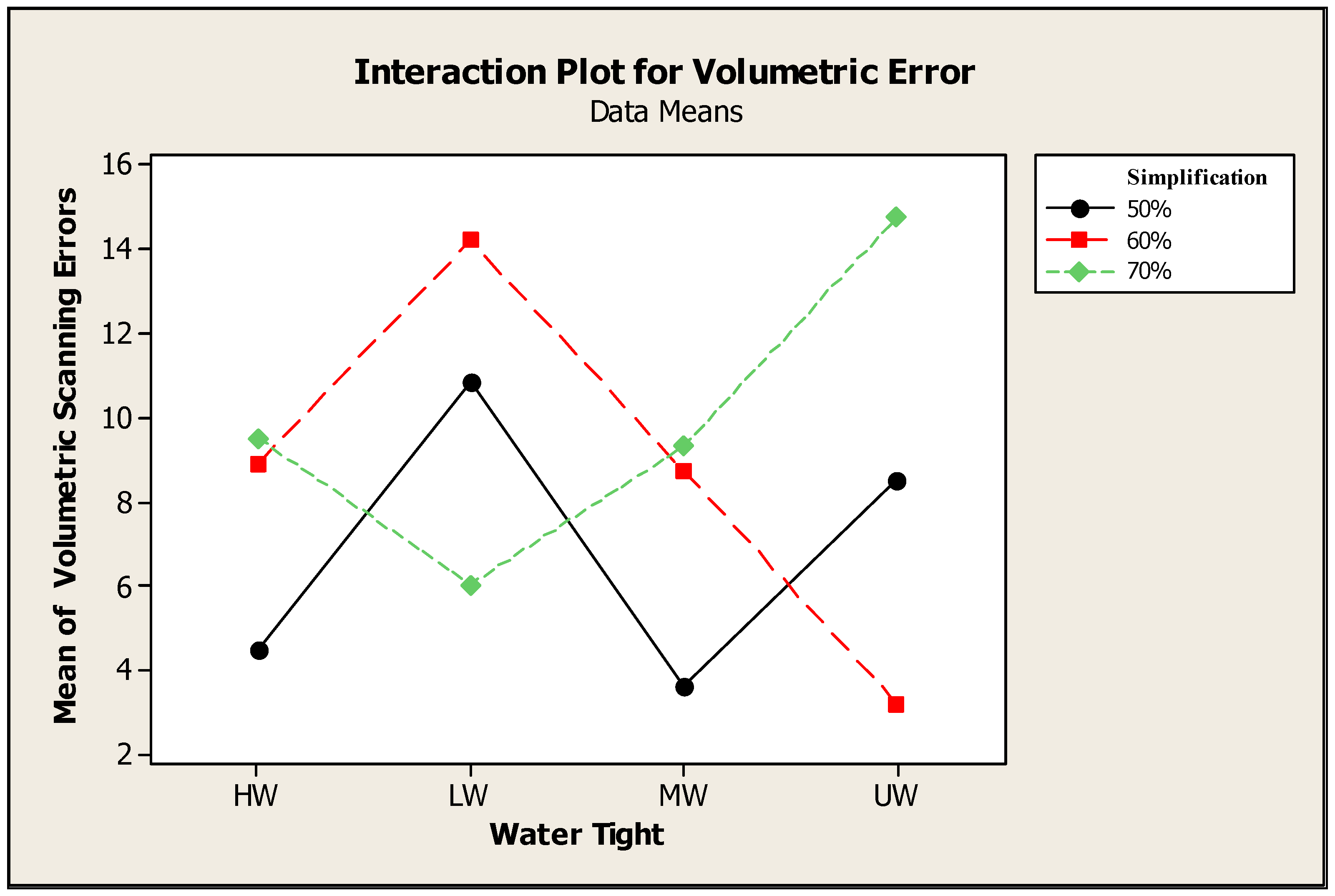
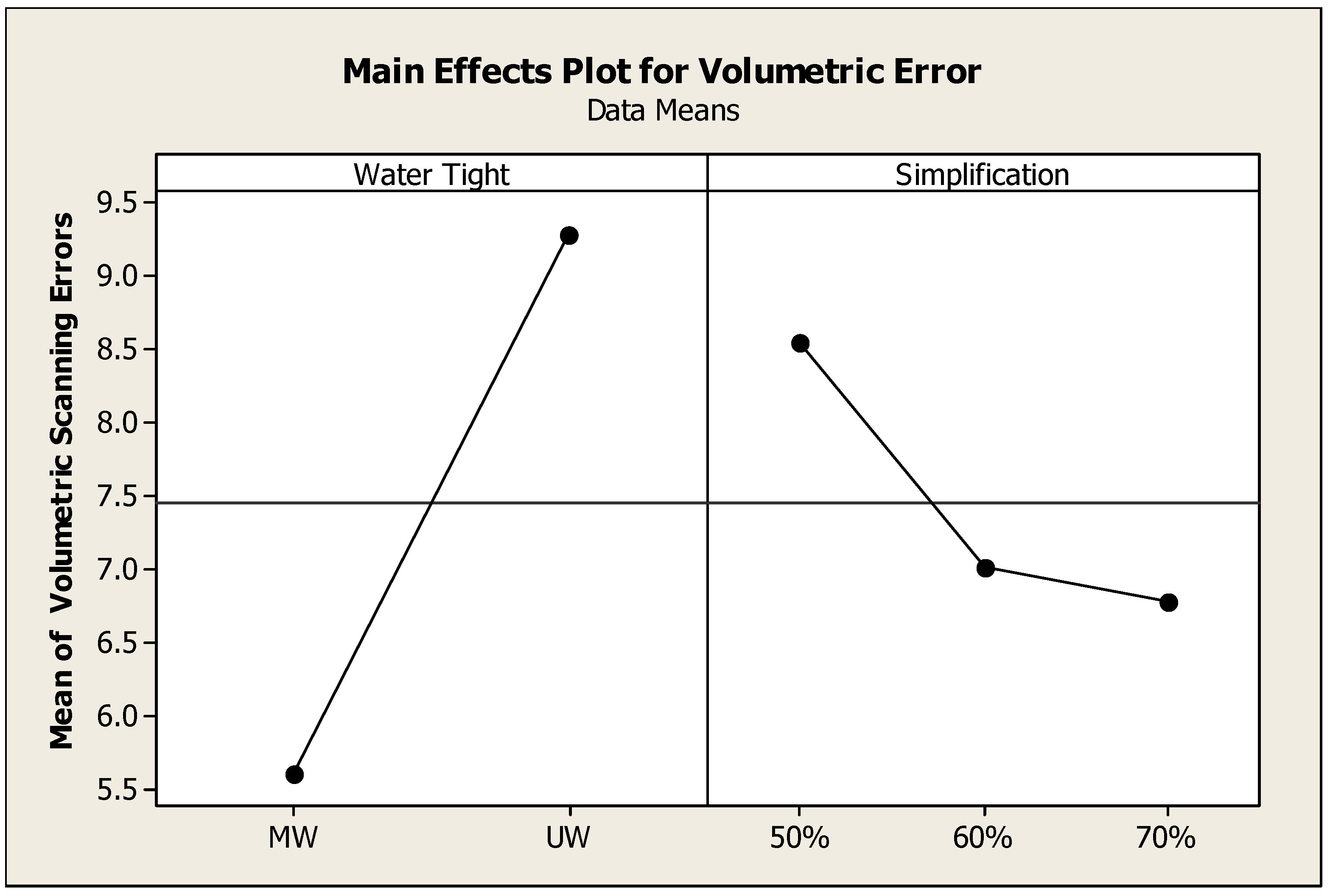
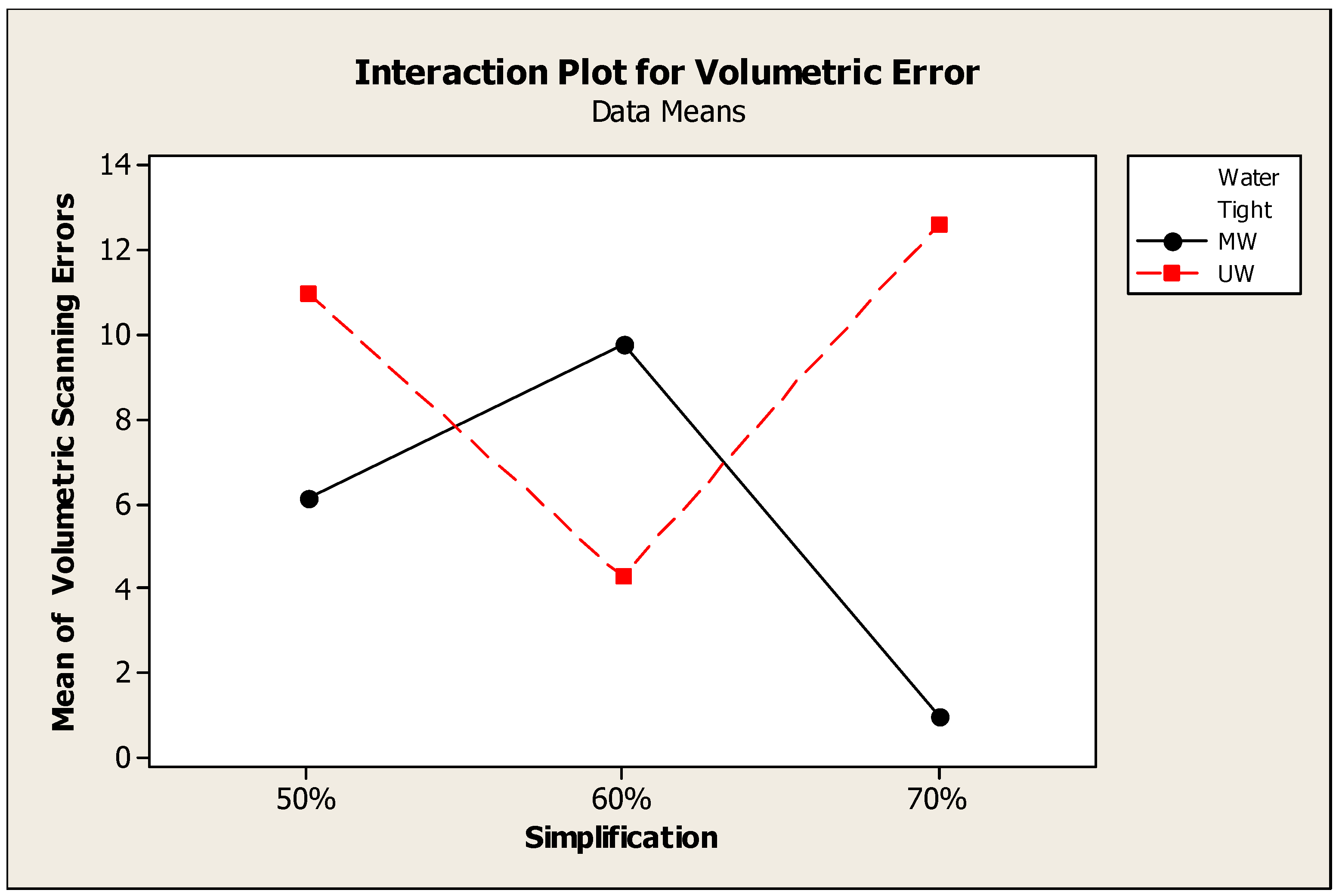
| Factors | Levels |
|---|---|
| Texture with Sharpness/Smoothness | |
| Watertightness | 4 (LW, MW, HW, and Un-watertight) |
| Simplification | 3 (50%, 60%, and 70%) |
| Non-Texture with Sharpness/Smoothness | |
| Watertightness | 2 (MW and UW) |
| Simplification | 3 (50%, 60%, and 70%) |
| Modes | 3D Scanning Factors * | |||||
|---|---|---|---|---|---|---|
| Watertightness | Simplification | Texture | Non-Texture | Smoothness | Sharpness | |
| A. | ✓ | ✓ | ✓ | ✗ | ✓ | ✗ |
| B. | ✓ | ✓ | ✓ | ✗ | ✗ | ✓ |
| C. | ✓ | ✓ | ✗ | ✓ | ✓ | ✗ |
| D. | ✓ | ✓ | ✗ | ✓ | ✗ | ✓ |
| Source | DF | Adj SS | Adj MS | F-Value | p-Value | PCR |
|---|---|---|---|---|---|---|
| Simplification | 2 | 18.87 | 9.43 | 0.5 | 0.64 | 12.30 |
| Watertightness | 3 | 17.94 | 5.98 | 0.3 | 0.82 | 11.69 |
| Error | 6 | 116.6 | 19.43 | 76.00 | ||
| Total | 11 | 153.40 |
| Source | DF | Adj SS | Adj MS | F-Value | p-Value | PCR |
|---|---|---|---|---|---|---|
| Watertightness | 1 | 20.157 | 20.157 | 0.54 | 0.538 | 20.53 |
| Simplification | 2 | 3.663 | 1.831 | 0.05 | 0.953 | 3.73 |
| Error | 2 | 74.321 | 37.160 | 75.72 | ||
| Total | 5 | 98.141 |
Disclaimer/Publisher’s Note: The statements, opinions and data contained in all publications are solely those of the individual author(s) and contributor(s) and not of MDPI and/or the editor(s). MDPI and/or the editor(s) disclaim responsibility for any injury to people or property resulting from any ideas, methods, instructions or products referred to in the content. |
© 2023 by the authors. Licensee MDPI, Basel, Switzerland. This article is an open access article distributed under the terms and conditions of the Creative Commons Attribution (CC BY) license (https://creativecommons.org/licenses/by/4.0/).
Share and Cite
Raza, S.F.; Amjad, M.; Ishfaq, K.; Ahmad, S.; Abdollahian, M. Effect of Three-Dimensional (3D) Scanning Factors on Minimizing the Scanning Errors Using a White LED Light 3D Scanner. Appl. Sci. 2023, 13, 3303. https://doi.org/10.3390/app13053303
Raza SF, Amjad M, Ishfaq K, Ahmad S, Abdollahian M. Effect of Three-Dimensional (3D) Scanning Factors on Minimizing the Scanning Errors Using a White LED Light 3D Scanner. Applied Sciences. 2023; 13(5):3303. https://doi.org/10.3390/app13053303
Chicago/Turabian StyleRaza, Syed Farhan, Muhammad Amjad, Kashif Ishfaq, Shafiq Ahmad, and Mali Abdollahian. 2023. "Effect of Three-Dimensional (3D) Scanning Factors on Minimizing the Scanning Errors Using a White LED Light 3D Scanner" Applied Sciences 13, no. 5: 3303. https://doi.org/10.3390/app13053303
APA StyleRaza, S. F., Amjad, M., Ishfaq, K., Ahmad, S., & Abdollahian, M. (2023). Effect of Three-Dimensional (3D) Scanning Factors on Minimizing the Scanning Errors Using a White LED Light 3D Scanner. Applied Sciences, 13(5), 3303. https://doi.org/10.3390/app13053303








